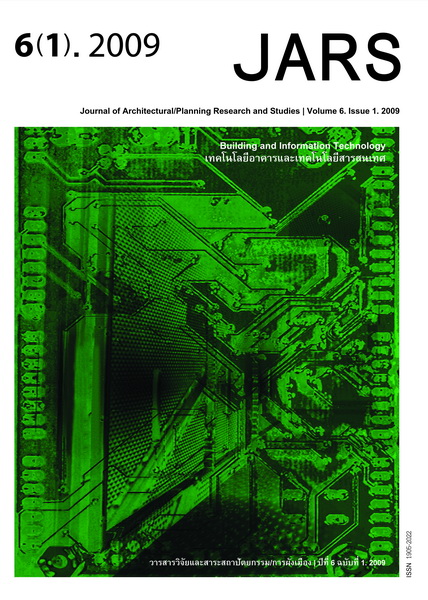Rice-Husk Silica Dehumidifying Wall Unit
Main Article Content
Abstract
A rice-husk silica dehumidifying unit was designed and tested. The purpose of the unit was to reduce
the energy consumption of an air-conditioning system by drying the intake air. The unit comprised two layers of
glazing. The space between the glazing was filled with acrylic fins coated with rice-husk silica. The unit had two
ventilation apertures: one at the top and one at bottom, with an exhaust fan at the top aperture. Two set of
experiments were carried out. The first set tested the dehumidifying ability of the unit under three environmental
conditions mimicking the key seasons in Thailand: summer, winter and rainy season. The second set of
experiments tested the dehumidifying ability of the unit in real life conditions. Theoretical analysis was then
carried out to evaluate the energy savings effected by the dehumidifying unit when installed in a small typical
bedroom. The analysis showed that the greatest savings could be made during the rainy season and the
smallest savings during summer. The unit absorbed moisture during the night and re-released it during the day,
enabling continuous and prolonged use without manual drying.
Downloads
Article Details

This work is licensed under a Creative Commons Attribution-NonCommercial-NoDerivatives 4.0 International License.
All material is licensed under the terms of the Creative Commons Attribution 4.0 International (CC-BY-NC-ND 4.0) License, unless otherwise stated. As such, authors are free to share, copy, and redistribute the material in any medium or format. The authors must give appropriate credit, provide a link to the license, and indicate if changes were made. The authors may do so in any reasonable manner, but not in any way that suggests the licensor endorses you or your use. The authors may not use the material for commercial purposes. If the authors remix, transform, or build upon the material, they may not distribute the modified material, unless permission is obtained from JARS. Final, accepted versions of the paper may be posted on third party repositories, provided appropriate acknowledgement to the original source is clearly noted.
References
ASHRAE. (2005). ASHRAE handbook: Fundamentals. Atlanta, GA: Author.
Boonyatikarn, S. (1999). เทคนิคการออกแบบบ้านประหยัดพลังงานเพื่อคุณภาพชีวิตที่ดีกว่า [Technique for energy saving house design for a better quality of life]. Bangkok, Thailand: Chulalongkorn University Press.
Chenvidyakarn, T. (2007). Passive design for the thermal comfort in hot humid climates. Journal of Architectural/Planning Research and Studies, 5(1), 1-27.
Damiano, L. A., & Dougan, D. S. (2004). ASHRAE standard 62.1. South Carolina, DC: Ebtron.
Gogkrue, S. (2003). การศึกษาเตรียมแผ่นสารดูดความชื้นเพื่อใช้ในการลดภาระความร้อนที่ผ่านหลังคา [A study of solid adsorption panel preparation for through-roof-heat-load reducing]. Master Thesis, Division of Materials Technology, King Mongnkut’s University of Technology Thonburi, Bangkok, Thailand.
Jaion, S. (2000). การปรับปรุงสภาวะภายในห้องที่มีการระบายอากาศด้วยปล่องระบายอากาศโดยใช้สารดูดความชื้นเชิงอุตสาหกรรม [Improving of indoor conditions of solar chimney ventilated building by industrial humidity absorber]. Master Thesis, Division of Energy Technology, King Mongnkut’s University of Technology Thonburi, Bangkok, Thailand.
Jongsuwanpaisan, T. (2003). ศึกษาความสามารถในการดูดซับความชื้นของซิลิกาที่สกัดดจากแกลบ [A study of dehumidity from rice-husk silica]. Research Report, Faculty of Architecture and Planning, Thammasat University, Pathum Thani, Thailand.
Kokanutranont, C. (1993). การคารบอไนซ์แกลบในอิไดซ์เบด [Carbonization of rice husk in fluidized]. Master Thesis, Department of Chemical Technology, Chulalongkorn University, Bangkok, Thailand.
Leela-adisorn, U. (1993). การเตรียมและศึกษาคุณลักษณะของซิลิกาคุณภาพสูงจากแกลบ [Preparation and characterization of high-grade silica from rice husk]. Bachelor Thesis, Department of Materials Science, Chulalongkorn University, Bangkok, Thailand.
Liwthanamongkol, N. (1995). รวมข้อมูลก่อสร้าง [Practical tables & data for building construction] (5th ed.). Bangkok, Thailand: Rungsaeng Karnpim.
Prueksapanich, S. (1986). การปรับอากาศ: หลักการและระบบ [Air conditioning: Basic principles and system]. Bangkok, Thailand: Physics Center.
Thirakomen, K. (2004). การประเมินระดับมาตรฐานอาคารยั่งยืน [Sustainable building assessment]. Journal of Architectural Research and Studies, 2, 1-21.


